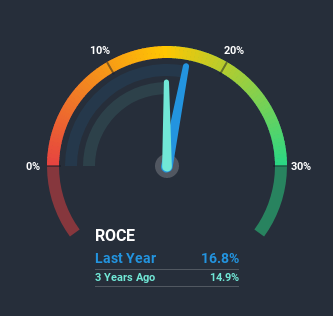Here’s What’s Happening With Returns At EMCOR Group (NYSE:EME)

What are the early trends we should look for to identify a stock that could multiply in value over the long term? One common approach is to try and find a company with returns on capital employed (ROCE) that are increasing, in conjunction with a growing amount of capital employed. If you see this, it typically means it's a company with a great business model and plenty of profitable reinvestment opportunities. So when we looked at EMCOR Group (NYSE:EME) and its trend of ROCE, we really liked what we saw.
What is Return On Capital Employed (ROCE)?
If you haven't worked with ROCE before, it measures the 'return' (pre-tax profit) a company generates from capital employed in its business. Analysts use this formula to calculate it for EMCOR Group:
Return on Capital Employed = Earnings Before Interest and Tax (EBIT) ÷ (Total Assets - Current Liabilities)
0.17 = US$479m ÷ (US$4.8b - US$2.0b) (Based on the trailing twelve months to September 2020).
Thus, EMCOR Group has an ROCE of 17%. On its own, that's a standard return, however it's much better than the 10% generated by the Construction industry.
See our latest analysis for EMCOR Group
Above you can see how the current ROCE for EMCOR Group compares to its prior returns on capital, but there's only so much you can tell from the past. If you'd like, you can check out the forecasts from the analysts covering EMCOR Group here for free.
So How Is EMCOR Group's ROCE Trending?
We like the trends that we're seeing from EMCOR Group. The data shows that returns on capital have increased substantially over the last five years to 17%. The company is effectively making more money per dollar of capital used, and it's worth noting that the amount of capital has increased too, by 31%. This can indicate that there's plenty of opportunities to invest capital internally and at ever higher rates, a combination that's common among multi-baggers.
On a separate but related note, it's important to know that EMCOR Group has a current liabilities to total assets ratio of 41%, which we'd consider pretty high. This can bring about some risks because the company is basically operating with a rather large reliance on its suppliers or other sorts of short-term creditors. Ideally we'd like to see this reduce as that would mean fewer obligations bearing risks.
What We Can Learn From EMCOR Group's ROCE
A company that is growing its returns on capital and can consistently reinvest in itself is a highly sought after trait, and that's what EMCOR Group has. Since the stock has only returned 38% to shareholders over the last five years, the promising fundamentals may not be recognized yet by investors. So exploring more about this stock could uncover a good opportunity, if the valuation and other metrics stack up.
Like most companies, EMCOR Group does come with some risks, and we've found 3 warning signs that you should be aware of.
While EMCOR Group isn't earning the highest return, check out this free list of companies that are earning high returns on equity with solid balance sheets.
This article by Simply Wall St is general in nature. It does not constitute a recommendation to buy or sell any stock, and does not take account of your objectives, or your financial situation. We aim to bring you long-term focused analysis driven by fundamental data. Note that our analysis may not factor in the latest price-sensitive company announcements or qualitative material. Simply Wall St has no position in any stocks mentioned.
Have feedback on this article? Concerned about the content? Get in touch with us directly. Alternatively, email editorial-team@simplywallst.com.

 Yahoo News
Yahoo News 
